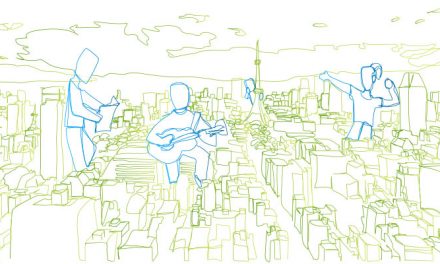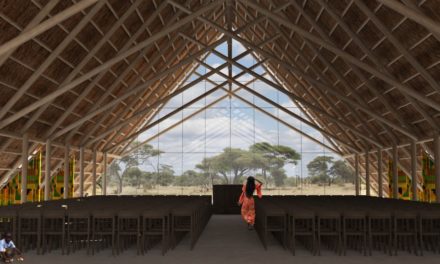The CfAD’s fourth annual Center for Active Design: Excellence awards recognize compelling research and design projects that cultivate health by promoting physical activity, mental health, and civic trust. This year’s Thought Leadership award recognizes Dr. James Sallis for his pivotal work to expand and disseminate research on the built environment and health.
NEW YORK, NY—August 2, 2017, the Center for Active Design® (CfAD) announced the 2017 winners of its annual Center for Active Design: Excellence awards. The breadth and quality of responses to this year’s call for submissions reveals that active design has become globally recognized as an essential approach to enhance holistic community health.
This year’s winning projects illustrate how active design has made a decisive transition, shifting from a special topic of interest among forward-thinking designers and researchers, to a commonly-espoused motivator driving all types of design and development practice. Winning projects illustrate how an emphasis on physical, mental, and social wellbeing can be achieved—through shifts in regional policies, grassroots advocacy campaigns, and the leveraging of health-promoting design as a key market differentiator.
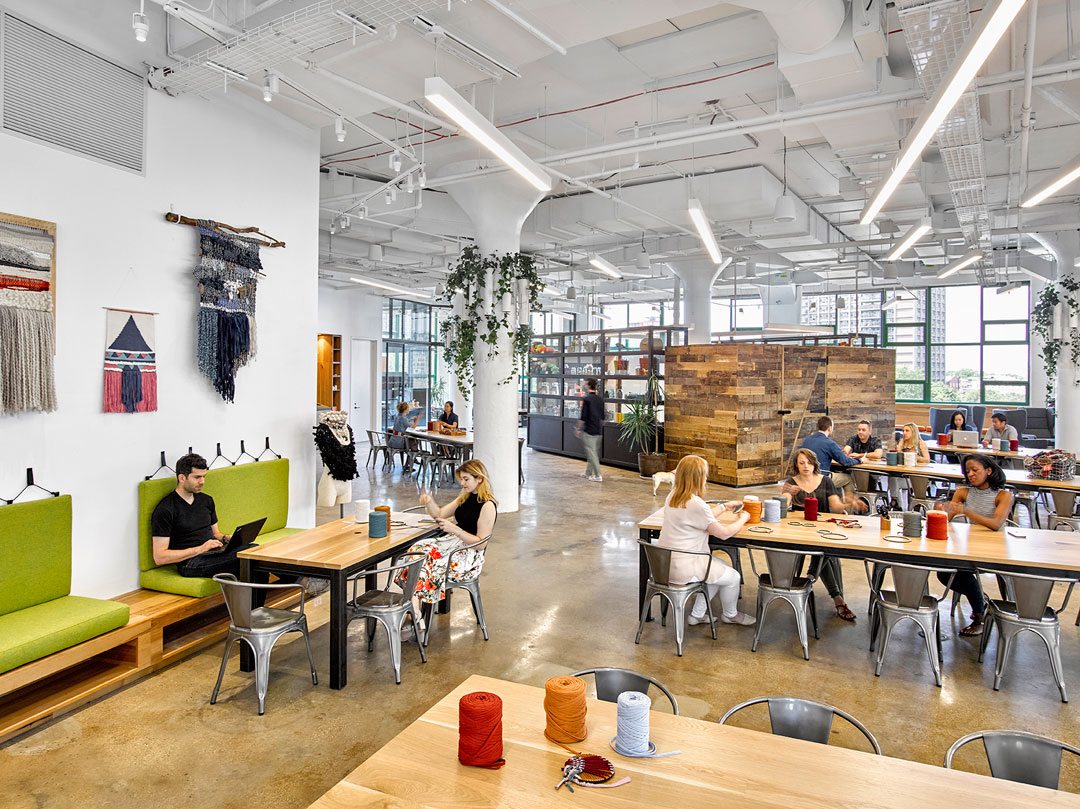
Etsy Headquarters, Brooklyn, N.Y. Photo credit: Garrett Rowland. Courtesy of Gensler
An independent jury recognized seven exemplary winners from around the world that demonstrate innovative design projects and research studies leveraging buildings, streets, and neighborhoods to support healthy and engaged communities. In addition to the project awards, CfAD identified one Thought Leadership award recognizing excellence in the field.
Two decades ago, academic researchers were just beginning to investigate how community design impacts health behaviors such as physical activity and healthy food consumption. One of the most pivotal figures making the case for this work was Dr. James Sallis, Distinguished Professor Emeritus of Family Medicine and Public Health at the University of California, San Diego and Professorial Fellow at Australian Catholic University, Melbourne, Australia.

Dr. James Sallis. Courtesy of James Sallis
This year’s Thought Leadership award recognizes Dr. Sallis’ influence in shaping the field, and elevating the essential role of scholarly research in formulating evidence-based design strategies to support health. Dr. Sallis has also actively promoted this research to built environment practitioners across numerous sectors, as well as to elected officials. He has authored over 600 scientific publications, and is the recipient of numerous accolades, including the lifetime achievement award from the President’s Council on Fitness, Sports, and Nutrition, and election to the National Academy of Medicine.
Today, CfAD continues to sit at the forefront of creating practical design solutions to foster healthy and engaged communities across a range of contexts and development typologies. Earlier this summer, with support from the John S. and James L. Knight Foundation, CfAD released findings from the “Assembly Civic Engagement Survey,” the first study of its kind to examine community design features that influence civic life, including civic trust.
CfAD is also the operator of Fitwel®,the premier healthy building certification system that has already gained widespread global adoption in the commercial building sector, with over 600 committed projects after only six months in the market. Named one of Fast Company’s 2017 Top Most Innovative Companies in Social Good, Fitwel was developed by the U.S. Centers for Disease Control and Prevention and U.S. General Services Administration.
“Over the five years since CfAD was launched, we’ve seen a shift in the demand for healthy communities that is now being led by the residents and employees within our communities,” says Joanna Frank, President & CEO, Center for Active Design, “As is evidenced by this year’s winners, cities, real estate developers, businesses, and designers are meeting this demand by prioritizing health within their respective industries.”
A jury of distinguished professionals with backgrounds in research, design, and urban development convened this summer to evaluate a short list of 50 Center for Active Design: Excellence award entries through a blind selection process. The process benefited from the expertise of the following jury members: Madeline Burke-Vigeland, Principal at Gensler; Susan Chung, Senior Research Associate at the American Society of Interior Designers; Linda Gibbs, Principal at Bloomberg Associates; Deb Gorhan, Americas Manager of Wellness & Health Promotion at Johnson & Johnson; and David Burney, FAIA, Board Chair of the Center for Active Design, Associate Professor at the Pratt Institute.
Details on all winning projects can be found on the Excellence awards website: http://awards.centerforactivedesign.org. Award recipients will be recognized at the annual “Celebrate Active Design” event, which will be held the evening of September 27, 2017 at WNYC’s The Greene Space. Celebrate Active Design will be open to the public, and tickets are available via the awards website.
2017 CENTER FOR ACTIVE DESIGN: EXCELLENCE AWARDS WINNERS
Macon Connects, Macon, Ga
“The impressive usage of this pop-up bike network really shows what’s possible when you tap into the community and can help inspire other cities and towns looking to boost physical activity among residents.” — Madeline Burke-Vigeland
As a winner of the Knight Cities Challenge grant program, Macon Connects brought five miles worth of pop-up bike lanes to Macon, GA for a week-long period during September 2016, all in an effort to change how residents travelled around town for the better. Macon Connects was a collaborative project led by NewTown Macon in partnership with Macon-Bibb County, 8 80 Cities, and the Better Block Foundation.
Prior to implementation, only 45 Macon residents, or .0003% of the population, reported commuting to work or school by bike. A true exhibition of “if you build it, they will come,” during Macon Connects, this number was 9.5 times higher, with 88% of those who had an opportunity to test out the lanes agreeing that the pop-up network inspired them to bike more.
This initiative engaged community members every step of the way, beginning with the more than 1,100 attendees who participated in an ideas festival, and made it extremely clear that Macon needed to boost mobility options for residents. For those unable to try out the bike lanes, the team also hosted a two-day block party to help increase reach and engagement. Based on the success of this initiative, Macon has already installed the city’s first mile-long bike lane, and is aiming to complete a second multi-neighborhood connection later this summer.
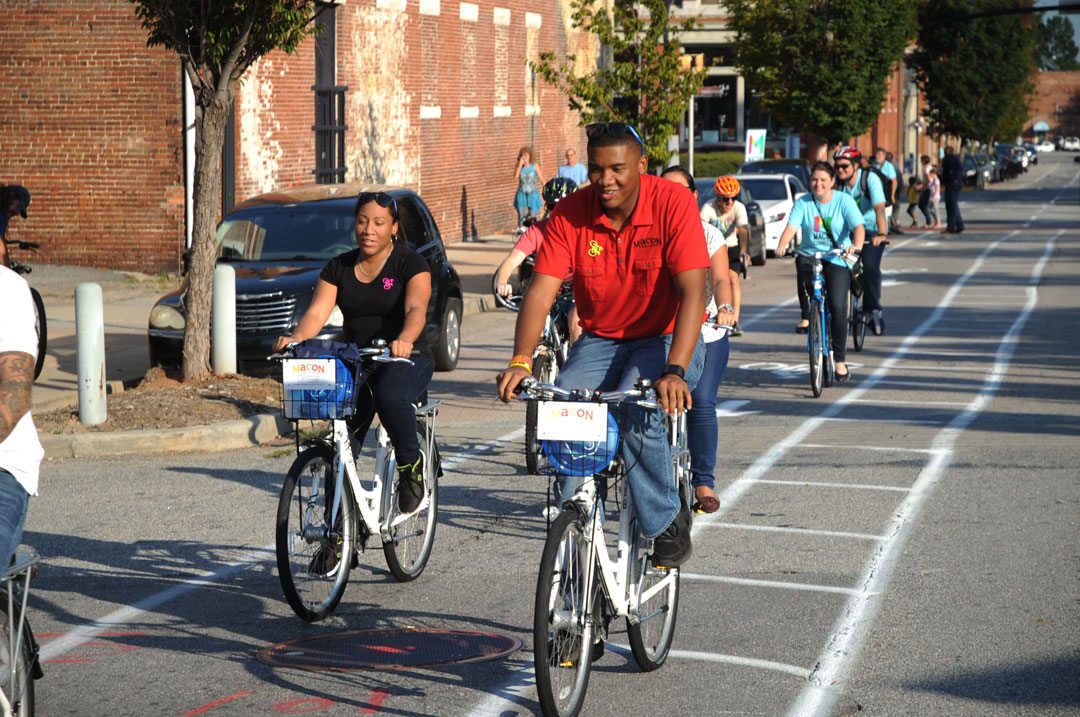
Macon Connects, Macon, Ga. Bikers. Courtesy of NewTown Macon
Veneto Active City, Veneto, Italy
“By bringing the same active design trends that are already spreading across larger metropolitan areas to smaller cities and towns, and showing how these strategies can help local governments achieve their goals, Veneto is pushing the movement forward and becoming part of something much bigger.” — Linda Gibbs
Veneto Active City, led by urban planners Corti Urbane (Urban Courtyards) in collaboration with its public partners, is an effort launched in 2010 to increase active transportation and ensure the safety of bikers and pedestrians. Veneto is a region in Italy made up of small towns and cities with less than 250,000 inhabitants each, and through a long-term, pragmatic approach, the region is working to reverse current transportation trends. In addition, by demonstrating how these shifts can help achieve local government goals of exceeding the EU climate and energy targets—which include cutting greenhouse gas emissions, increasing renewable energy use to 20% of all energy consumed, and improving energy efficiency by 20%—this effort has been able to gain support from the Covenant of Mayors.
Through improvements in road safety measures, expansion of community gathering spaces, and developments in the bicycle infrastructure, Veneto Active City has already hit several key milestones, including a 40% annual increase in cycling and pedestrian traffic. Through this effort, Corti Urbane hopes to influence how planners think of small urban centers, where more than 60% of Europeans reside, and help show how improved pedestrian zones, cycling lanes, and public transportation can improve resident health.
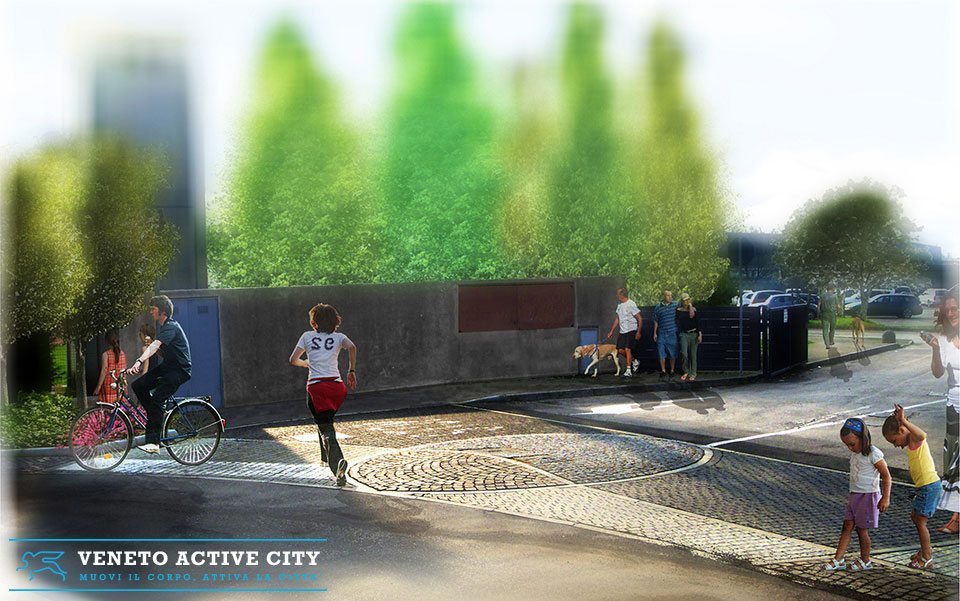
Veneto Active City, Veneto, Italy. Courtesy of Corti Urbane
Etsy Headquarters, Brooklyn, N.Y.
“By inviting the public into the ground floor, maintaining a fun and whimsical aesthetic, and featuring handmade artwork throughout the office, the Etsy headquarters really highlights the company’s commitment to not only its employees, but also the broader community of creators and artists.” — Susan Chung
In May 2016, Etsy, an e-commerce site built around the talents of its community, opened up its new headquarters in the DUMBO neighborhood of Brooklyn in New York City. While working with global design firm Gensler, Etsy remained focused on ensuring the space would fully reflect its goals as a company, support the wellbeing of its employees, and promote the success of the local maker community. Based on this mission, the space not only incorporates traditional active design strategies throughout the office, such as ample greenery visible from any seat and easily accessible stairs connecting all levels, but has also opened up the first floor to the community, using it as a public space and art gallery.
Housing a workforce with many unique needs, the design allows employees to “self-author” the space, providing a wide range of areas, including common areas, cafes, booth seating, small phone rooms, larger conference rooms, and more traditional desks. With locally prepared healthy meals provided through a global food program known as “Eatsy,” roof terraces, yoga and meditation rooms, workshop and studio space, employee and public education events, abundant access to daylight and views of the Manhattan skyline, among many other programs and amenities, the space demonstrates a unique commitment to holistic health and community cohesion.
Etsy’s new global headquarters is one of the largest Living Building Challenge Petal-Certified buildings in the world and the only LBC certified building in New York City.
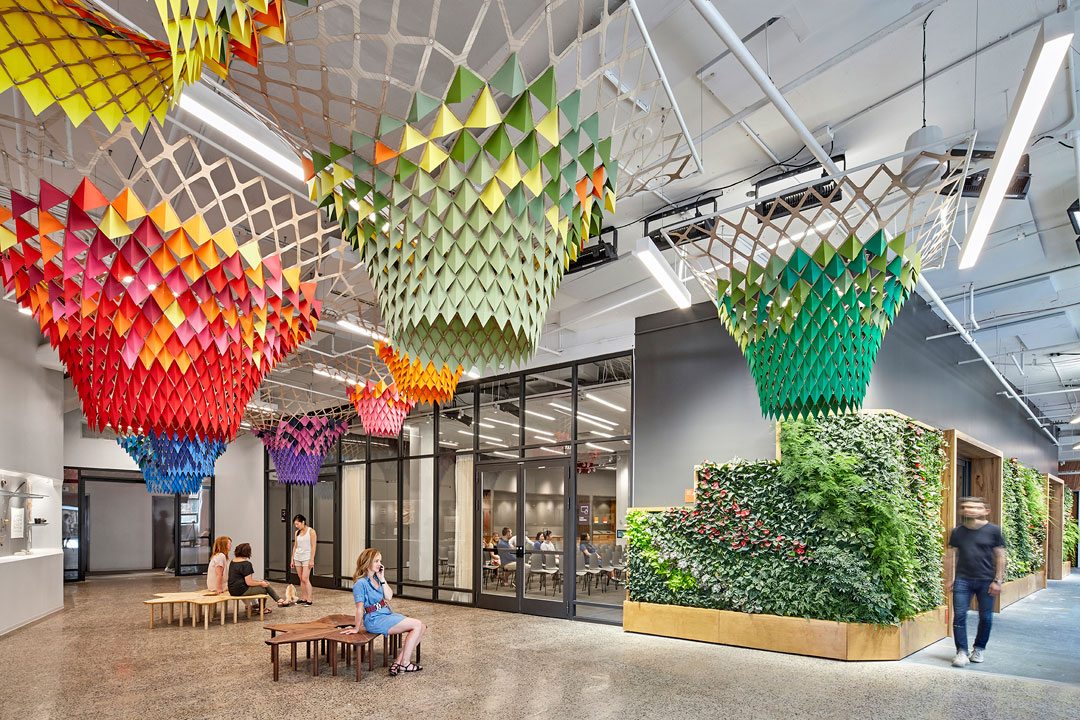
Etsy Headquarters, Brooklyn, N.Y. Photo credit: Garrett Rowland. Courtesy of Gensler
North Kansas City Schools: Students in Academically Gifted Education (SAGE), Gladstone, Miss.
“This building reimagines what a school can look like, highlighting how design can help support student learning in new and innovative ways.” — David Burney
Inserted into a newly constructed office space, the North Kansas City School District, interdisciplinary, research-based architecture and design firm Perkins+Will, and associate architect Hoefer Wysocki Architects worked within the confines of the space available to design a learning environment that encourages elementary-age students in the Students in Academically Gifted Education (SAGE) program to think creatively and work collaboratively with classmates. With students at SAGE only spending 5% of their time in structured lecture-style classes, the new center focuses on supporting active, participatory learning.
In addition to an outdoor patio for open-air lessons, the school features movable furniture, open spaces, strategic positioning of wide staircases, all to create a more dynamic setting. The team also decided not to assign specific desks for each teacher, encouraging them to share ideas and observe one another’s classes. This strategy has reportedly helped to increase camaraderie and support a level of collaboration that teachers say didn’t previously exist. With administrators and educators from across Missouri visiting SAGE, the site has become a model for schools looking to create a more active environment.

North Kansas City Schools: Students in Academically Gifted Education (SAGE), Gladstone, Miss. Photo credit: Alistair Tutton Photography. Courtesy of Perkins+Will
Elmhurst Library, Queens, N.Y.
“The idea that a library can be a beautiful and active place will help show other towns and cities what is possible as the role of libraries continues to transition towards becoming more of a community space for all.” — Deb Gorhan
Located in one of the fastest growing and ethnically diverse residential neighborhoods of Queens, the Elmhurst Library draws approximately 1.2 million annual visitors, continually serving its more than 80,000 library card holders, who speak over 57 languages. The brand-new space, which opened in December 2016, was designed by Marpillero Pollak Architects, the Queens Borough Public Library, and the NYC Department of Design and Construction to embrace its identity as a community institution.
By choosing a location visible from the subway station across the street and featuring improved outdoor spaces, including a 24/7 entry plaza with constant WiFi access for QL cardholders, a Historic Community Park, and a learning garden, the building provides residents with a unique space that meets a wide range of needs. In addition, the library’s design enables after-hours access to an Adult Learning Center and Multipurpose Room, increasing opportunities for community programs, such as Tai Chi classes, dance workshops, and discussions of relevant civic issues.
Through a focus on integrating the indoor and outdoor spaces, emphasized by the z-shaped massing and transparent center, the library offers its patrons an active and vibrant environment, animated by views, art, displays, resources, and events. The reading rooms, also known as cubes, glow in the nighttime, announcing the library’s presence as a safe and welcoming space for community members.

Monumental stair. Elmhurst Library, Queens, N.Y. Copyright Marpillero Pollak Architect
Nixon Peabody, LLP, Washington, D.C.
“The Nixon Peabody space contradicts the traditional corner office mentality, going against common perceptions of what a law firm should look like. Plus, anyone who can get lawyers out of their office, deserves at least a little bit of credit.” — Linda Gibbs
Charged with reducing the size of its office by 30% but still designing for growth, Nixon Peabody, LLP had to find a way to make a smaller workplace feel larger. This challenge led them away from characteristics common across law firms as they began working with designers at Perkins+Will to create a space that would encourage collaboration and communication across teams.
The three floors of the office are connected by a living wall, which runs adjacent to a monumental staircase connecting all office floors, improving the indoor air quality and encouraging occupants to stay active throughout the day. The use of frameless clear glass for office fronts and doors provides outdoors views and allows natural light to flow into the supporting staff’s workstations, with more than 90% of staff having direct views to the outside, a significant increase from the firm’s previous building.
In addition, collaborative team rooms sit in spaces traditionally reserved for corner offices and quiet rooms are placed around the office, encouraging employees to move away from their individual workstations throughout the day. Healthy snacking options such as fruits and nuts are available in the office, and filtered drinking water stations are placed in café and coffee areas.
Aligning with the firm’s commitment to sustainability and social responsibility, the new office has used photovoltaic panels on the roof to not only offset Nixon Peabody’s energy use, but also that of a nearby low-income housing project.
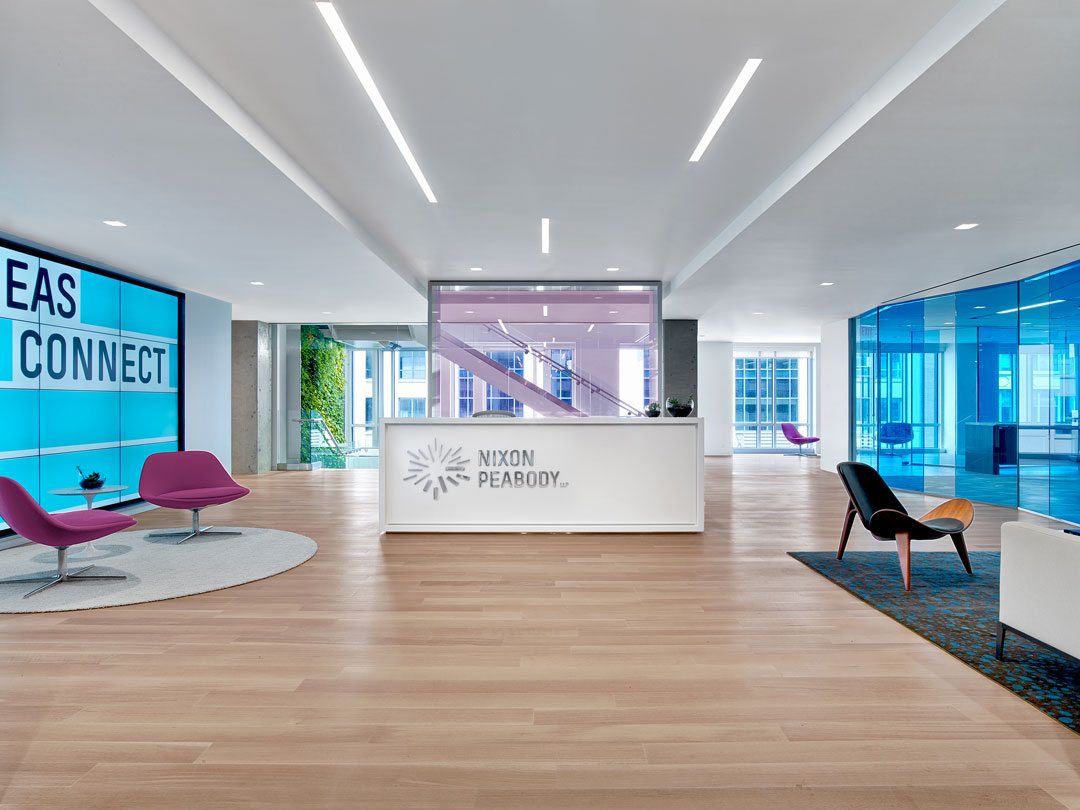
Firm lobby. Nixon Peabody, LLP, Washington, D.C. Photo Eric Laignel. Courtesy of Perkins+Will
Evaluation of the Liveable Neighbourhood Guidelines, Perth, Australia
“This research project provides real data on how the built environment affects our wellbeing. While we encourage government and other decision makers to pursue policies that we believe lead to healthy communities, we often lack the evidence to support those policies. This nine-year study is a model for how we can fill that evidence gap.” — David Burney
The Healthway-funded RESIDential Environments Projects (RESIDE), conducted by an award-winning research team at The University of Western Australia’s Centre for the Built Environment and Health (CBEH) in collaboration with researchers now at RMIT University’s NHMRC Centre for Research Excellence in Healthy Liveable Communities, set out in 2003 to evaluate the impact of the Liveable Neighborhoods (LN) Policy on people living in LN-designed and other communities.
They specifically looked at urban design features related to the movement network, urban structure, residential diversity, public open space, and schools. Through four surveys, the longitudinal study analyzed data from around 2,000 new home owners planning to relocate to one of 73 new housing developments across the metropolitan Perth and Peel region. Built environment measures were also created in GIS for each participant, in order to monitor changes to their neighborhoods over the survey period.
The study found that there was room for improvement when it comes to adhering to the Living Neighborhood Policy, as it was only 50% implemented. However, they also discovered that for every 10% increase in overall LN policy compliance, participants were 53% more likely to walk locally, 40% less likely to feel unsafe from crime, 14% more likely to have better mental health and 22% more likely to have a sense of community. The study highlighted the importance of well-implemented urban design policies to achieve better outcomes.
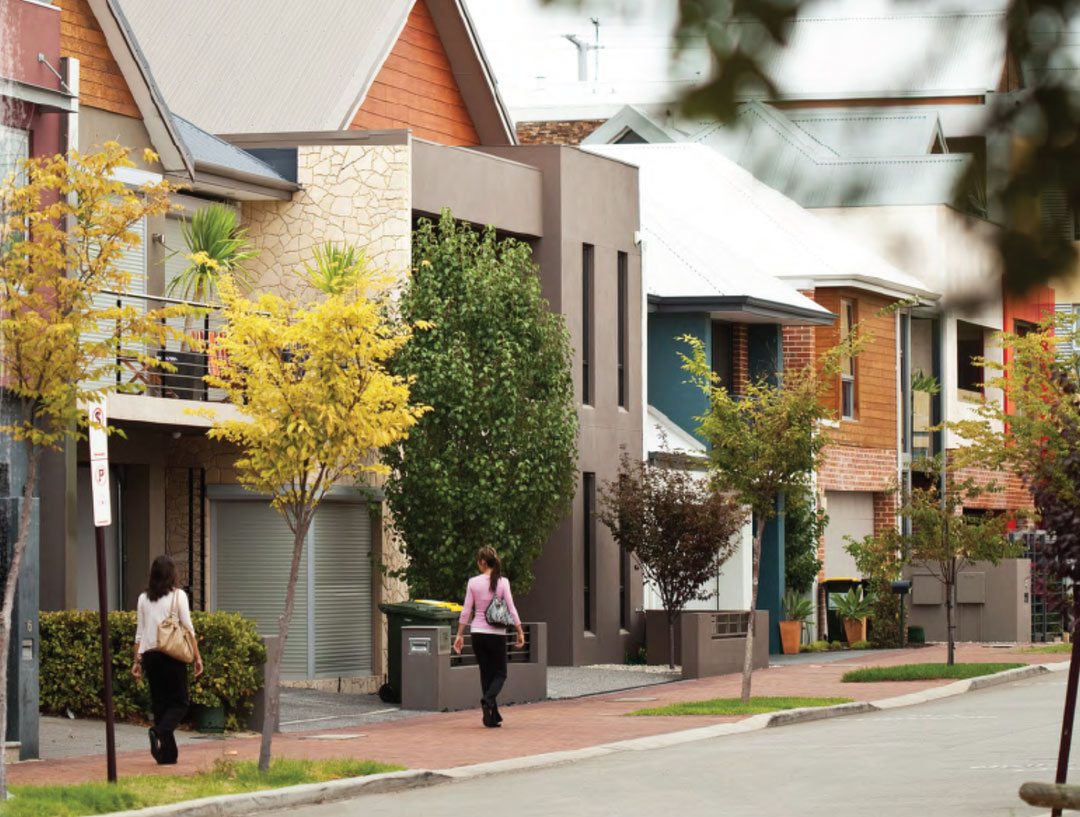
Evaluation of the Liveable Neighbourhood Guidelines, Perth, Australia. Photo: Centre for the Built Environment at the University of Western Australia.
The Center for Active Design (CfAD) is the leading international non-profit organization that uses design to foster healthy and engaged communities. CfAD takes a multi-disciplinary approach to translating research into practical design solutions. CfAD guides the creation and implementation of initiatives that respond to unique community priorities and result in measurable outcomes. For more information about CfAD, please visit www.centerforactivedesign.org and follow CfAD on Twitter @active_design.



